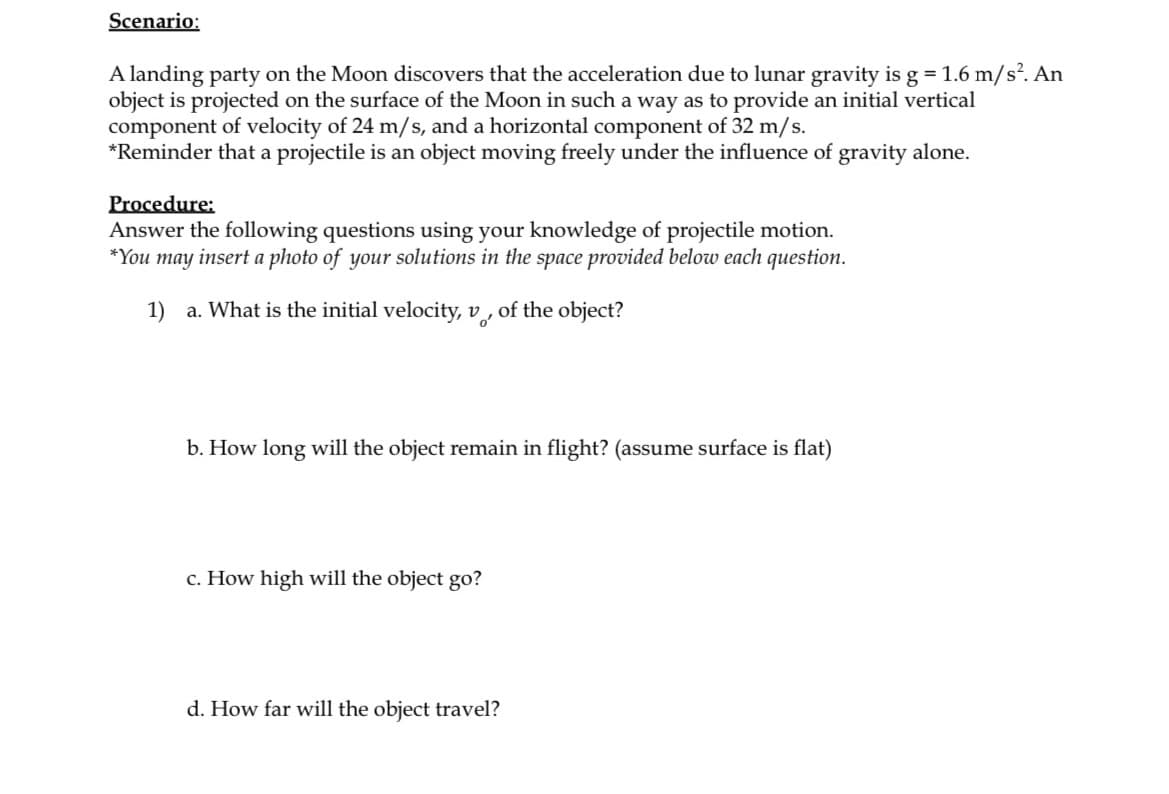A landing party on the Moon discovers that the acceleration due to lunar gravity is g 1.6 m/s?. An object is projected on the surface of the Moon in such a way as to provide an initial vertical component of velocity of 24 m/s, and a horizontal component of 32 m/s. *Reminder that a projectile is an object moving freely under the influence of gravity alone. Procedure: Answer the following questions using your knowledge of projectile motion. *You may insert a photo of your solutions in the space provided below each question. 1) a. What is the initial velocity, v , of the object? b. How long will the object remain in flight? (assume surface is flat) c. How high will the object go? d. How far will the object travel?
A landing party on the Moon discovers that the acceleration due to lunar gravity is g 1.6 m/s?. An object is projected on the surface of the Moon in such a way as to provide an initial vertical component of velocity of 24 m/s, and a horizontal component of 32 m/s. *Reminder that a projectile is an object moving freely under the influence of gravity alone. Procedure: Answer the following questions using your knowledge of projectile motion. *You may insert a photo of your solutions in the space provided below each question. 1) a. What is the initial velocity, v , of the object? b. How long will the object remain in flight? (assume surface is flat) c. How high will the object go? d. How far will the object travel?
An Introduction to Physical Science
14th Edition
ISBN:9781305079137
Author:James Shipman, Jerry D. Wilson, Charles A. Higgins, Omar Torres
Publisher:James Shipman, Jerry D. Wilson, Charles A. Higgins, Omar Torres
Chapter2: Motion
Section: Chapter Questions
Problem HM
Related questions
Question
Use the formulas with Sin etc.

Transcribed Image Text:Scenario:
A landing party on the Moon discovers that the acceleration due to lunar gravity is g = 1.6 m/s². An
object is projected on the surface of the Moon in such a way as to provide an initial vertical
component of velocity of 24 m/s, and a horizontal component of 32 m/s.
*Reminder that a projectile is an object moving freely under the influence of gravity alone.
Procedure:
Answer the following questions using your knowledge of projectile motion.
*You may insert a photo of your solutions in the space provided below each question.
1) a. What is the initial velocity, v,
of the object?
b. How long will the object remain in flight? (assume surface is flat)
c. How high will the object go?
d. How far will the object travel?
Expert Solution
This question has been solved!
Explore an expertly crafted, step-by-step solution for a thorough understanding of key concepts.
Step by step
Solved in 2 steps

Knowledge Booster
Learn more about
Need a deep-dive on the concept behind this application? Look no further. Learn more about this topic, physics and related others by exploring similar questions and additional content below.Recommended textbooks for you

An Introduction to Physical Science
Physics
ISBN:
9781305079137
Author:
James Shipman, Jerry D. Wilson, Charles A. Higgins, Omar Torres
Publisher:
Cengage Learning

Physics for Scientists and Engineers, Technology …
Physics
ISBN:
9781305116399
Author:
Raymond A. Serway, John W. Jewett
Publisher:
Cengage Learning

Principles of Physics: A Calculus-Based Text
Physics
ISBN:
9781133104261
Author:
Raymond A. Serway, John W. Jewett
Publisher:
Cengage Learning

An Introduction to Physical Science
Physics
ISBN:
9781305079137
Author:
James Shipman, Jerry D. Wilson, Charles A. Higgins, Omar Torres
Publisher:
Cengage Learning

Physics for Scientists and Engineers, Technology …
Physics
ISBN:
9781305116399
Author:
Raymond A. Serway, John W. Jewett
Publisher:
Cengage Learning

Principles of Physics: A Calculus-Based Text
Physics
ISBN:
9781133104261
Author:
Raymond A. Serway, John W. Jewett
Publisher:
Cengage Learning

Physics for Scientists and Engineers with Modern …
Physics
ISBN:
9781337553292
Author:
Raymond A. Serway, John W. Jewett
Publisher:
Cengage Learning

Physics for Scientists and Engineers
Physics
ISBN:
9781337553278
Author:
Raymond A. Serway, John W. Jewett
Publisher:
Cengage Learning

Physics for Scientists and Engineers: Foundations…
Physics
ISBN:
9781133939146
Author:
Katz, Debora M.
Publisher:
Cengage Learning